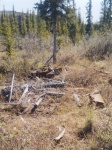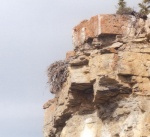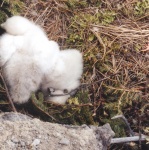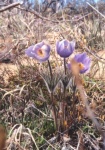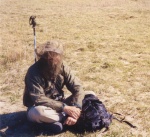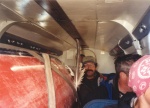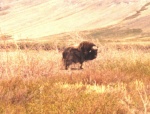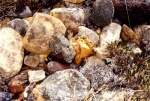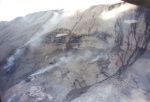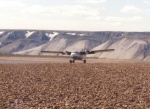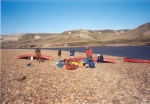There’s something that keeps drawing me back to the North. After four journeys, one would think that the answer would be plainly obvious. But now, as I sit on the grassy tundra by the Horton River, Northwest Territories, I have to confess that I am still unsure of exactly what it is.
Today is the last full day of my 12-day Horton River trip; we return to “civilization” tomorrow. A warm wind is blowing in my face. Mosquitoes, all but absent for the bulk of the trip, have finally found us. The 15 mph wind keeps the mosquitoes away, but I hear them behind me on my leeward side, waiting for the moment that the wind stops to strike!
We’ve enjoyed perfect weather since day one: No rain, cool breezes, and no bugs. The nights (an odd construct where the sun shines 24-hours a day) have been chilly. We often found a thin layer of ice on the washbasin. We’ve also experienced a snow flurry, a sandstorm, and fairly obnoxious headwinds, but for the most part, I was warm, dry, and truly brought all the right gear for this trip. (Compare this with my last trip; wet, cold, buggy).
The Horton is in Canada’s Northwest Territories, flowing north from the “Barrenlands” into the Arctic Ocean. It’s extremely remote, with no signs of settlement or habitation. We met no other groups, saw few airplanes, and felt truly isolated. We were told that even the Inuit of Paulatuk, the nearest community, rarely travel this far.
The hilltops and plateaus that surround me are covered with grasses, moss, stunted willows, and an incredible number of flowers. The plateaus, particularly those at the beginning of our journey, rose 600 feet above the valley floor. Climbing to the tops of these was relatively easy, as the huge alluvial fans provided a comfortable graded path. As the river traveled north, the hills became lower, perhaps 150 feet.
Starting off as a clear, quickwater river that meanders across an arctic plateau, the Horton weaves back and forth; getting larger and murkier as one heads towards the coastline. This river is known for its wildlife, of which there was no shortage. Every day brought sightings of a range of birds, caribou, and many other animals.
The riverbanks have three distinct zones. At the river’s edge is gravel, sand, and mud. Nothing grows there except for the occasional tenacious willow. It seems that the Horton’s high water line effectively scrubs any vegetation from this area. The next band is the flood zone. Sparse vegetation, heavy erosion, yet a fair number of small plants successfully colonized this band. It looks as if the floods were short lived, perhaps only during times when upriver ice dams burst. Some of these middle-zoned bands were littered with school bus sized pans if white ice. Flat protected areas upriver from here hosted stunted pines, often in dense stands. But, for the most part, short willows were the dominant larger plant.
From the air, the phenomenon of patterned ground or tundra polygons is clearly visible. But from the ground, these 30-100 foot polygons seemed almost impossible to discern. At this last campsite, we finally began to recognize them – and then they suddenly appeared everywhere. These patterns are made when ice forms in cracks in the ground. Each year, the cracks fill with water, freeze, expand, and then repeat the process. The surface of the cracks gets covered with soil and vegetation, and the ice extends into the permafrost layer, usually just 2-3 inches below the soil line. The valleys of the polygons are about 12 inches deep and about 3 feet across.
The ground varies widely. Gravel bars, made up of rocks from potato-sized all the way down to fine sand, were always a source of fascination by all. The river stones were fantastically varied, many being polished quartz, schist, jet-black granite, shale, slate, limestone, marble, fools gold, and just about everything else imaginable. Sometimes the gravel bars were smooth, with the rocks cemented in place by a layer of mud, arranged like a well-planned patio. At other times, we stumbled over loose scree, spongy sphagnum, tundra hummocks, and sticky mud.
Today I’m wearing my bug shirt and I’ve slathered on the Deet – both of which have gone unused for most of this trip. It’s been mercifully mosquito free, perhaps because of the cool windy weather. I came prepared for an onslaught like I experienced on the Burnside River, and managed to avoid even one bite until just today. While the mosquitoes are numerous, particularly by the kitchen area and the mid-level trail between the altiplano and the tenting area, they’re not impossible. The few that found their way into my tent did not even bite. They seemed to patiently wait for the mosquito-reaper.
Each day on the Horton was like being a part of a Discovery Channel show; except we were there. We saw countless caribou, sometimes alone, sometimes in groups of two, three, or up to 20. They were skittish but came quite close when we were quiet and still. These caribou were around us every day of the trip, even one in front of us on our “runway” as we departed. Sometimes the caribou were lazily grazing on a hillside; they seemed to like standing on hilltop ridges, perfectly silhouetted against the clear sky. Sometimes they were swimming across the river; and shook off the water like dogs after the rain, creating a misty halo around themselves. Although quite large, they were graceful, fast runners, excellent swimmers, and very enjoyable to watch.
We saw many muskoxen gazing on the valley’s sloping banks. At first, they simply appeared as brown dots, impossible to distinguish from the other thousands of brown lumps that dotted the tundra. But our sharp-sighted Inuvialuit guide, Enoch, pointed out these dots without the use of binoculars. We were soon spotting many muskoxen, and camped near a small herd to get a closer view. When we hiked up the hill, we accidentally got WAY TOO CLOSE, and wound up surprising both them and us. The muskoxen retreated a few yards, grouped in a defensive circle, and looked as if they were going to charge us; we apparently cut off their escape route. All of us were very scared, including Enoch, our guide. But the muskoxen chose to back off (was it our trekking poles?) and beat a hasty retreat to the next mountain. This all happened too fast for me to even think of getting out my camera, as I was not prepared for taking my eyes off them for even one second. Perhaps one of the others got a good photo.
Throughout the trip, we seemed to attract wildlife. In one lunch spot, we were approached by about 20 caribou. They got very close, but then split into two groups, some heading across the river, the other staying on our side but moving into the willows. They seemed oddly spooked. In a few minutes we found out why: a grizzly had just killed a caribou directly in front of where we were. Not wanting to have a close bear encounter, we also retreated across the river to have lunch. The grizzly shortly reappeared, got spooked by us, then an arctic wolf came to the kill. First, the wolf downed three siksiks (apparently the official snack food of the arctic), and then consumed some leftover caribou. After he left the scene, Tim (a fellow traveler) and I visited the site, aided by a few million flies, and looked over the caribou’s remains.
Siksiks, an arctic ground squirrel, are ubiquitous but elusive. It was clear that every arctic carnivore was fond of these cute ermine-like animals. Whenever we got near, they quickly scooted back in their holes.
When we put in, the river was running fast, clear, and cold. In the warm sun, we were able to go for a dip without risking our lives – or ending up dirtier than when we started. The clear water had many fish, which our expert angler found when he went fishing for the first two days. Arctic terns and gulls indicated the best spots. But soon, the river got muddier, and now the terns and gulls disappeared, and so have the fish. Remarkably, a beaver swam up to us at this last campsite.
One of the most interesting features of this area is the “Smoking Hills” – hillsides that are burning. This phenomenon is the result of iron sulfide-rich marine shale that produces great heat when it oxidizes. As hillsides crumbles from erosion, fresh deposits of this combustible shale are exposed. Downwind from these “vents”, the smell of sulfur is unmistakable. Fanned by winds, they smolder constantly.
As I’m writing this today, we’re camped across the river from an arctic fox. The den is fresh, but the fox is avoiding us. We’ve spotted him when we’re on our side, but as soon as we cross, he disappears. We also seem to be on a major caribou thoroughfare. There are almost always caribou on the adjacent hillside.
This campsite has three levels. The top, which I’ve dubbed the altiplano, is where we’ve tented. Its windswept surface is covered by short grasses, flowers, and tussocks. It’s the most comfortable spot, but there are few mosquitoes. The middle plain across a small stream is where the caribou keep wandering. We’ve had some of our meals there. The riverbank is where we’ve set up the kitchen. The steep mud bank protects us from the wide, but also allows the mosquitoes to harass us. From the kitchen to the altiplano, it’s about 70 feet ascent, and part of the trail leads straight thru a stand on 2’ high willows. The mosquitoes LOVE this area, and rise up to greet us whenever we walk thru.
The altiplano is actually the remnants of an old alluvial fan. It overlooks the Horton valley, and extraordinary vista. From here, where I sit, I can for miles in each direction, and have a beautiful vantage point to see the two of the river’s S curves. There’s supposedly just one more long “S” after this one before the Horton spills into the Arctic Ocean. But we aren’t planning to canoe of hike there. Behind me is another large rounded hill, rising just another 75 yards.
Yesterday, when we hiked over this hill, we were greeted by a spectacular view of the Arctic Ocean. We arrived at high tide. The bay before us was mostly covered with pack ice. It was perfectly motionless, no breeze, no waves, and seemingly no life. But as we studied the scene more closely, we began to pick out black dots on the ice; seals were hauled out basking in the early evening light. We spotted arctic murres, penguin-like birds floating high in the water, and many ducks. The scene was dreamlike, the eerie stillness made it feel that time was standing still. Brett and Enoch hiked down to the shore, – about a 200 ft descent – and disappeared for what felt like an eternity.
The summer in the arctic is short – perhaps just a few weeks. In that short period, flowers bloom, insects buzz, willows leaf out at an amazing rate, as if being viewed with time-lapse photography. We were constantly surrounded by hills covered with strawberry-like white flowers, yellow buttercups, pinks, reds, and bright green sphagnum moss. Willows grew everywhere, sometimes as 4-foot shrubs, sometimes as 1” high creepers. When we started out journey, the hills were dotted with stands of conifers. By the end, there was only tundra. Some hills were only bare rock, mud and shale.
Within the river valley is a large gravel bar covered with potato-sized rocks from which a Twin Otter just took half our group back to civilization. Across the river is our now-abandoned campsite and beyond that, rolling hills, alluvial fans, and an ancient flood plain that’s being quickly eroded into the river valley below. The scene is magnificent, peaceful, and serene. The tranquility has a tremendous effect on me. A strong cool wind is in my face. A caribou is standing less than 100 yards away – staring at me. The sun is getting lower on the horizon. It’s a perfect the end of a perfect journey.
Outfitter/Guide
Nahanni River Adventures – www.nahanni.com.
This was my fourth trip with them. They are a superb organization that pays attention to detail, safety, and comfort.

